Home > About KYUDO > The History of Kyudo

The Japanese Yumi
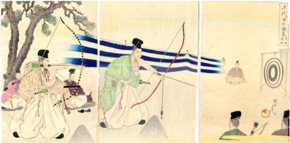
The origin of the bow dates back a long time in history. Bows were already in use by ethnic groups in the Middle East and Asia during the end of the Stone Age.
In Japan, artifacts of bows likely to be from the same period have been discovered as well. It is estimated that they were made between AD1 to AD3 during the Yayoi Period. These bows were maruki-type long bows made from a single piece of wood; painted in black and bound by birch. Also, in depictions of hunting scenes drawn on bell-shaped bronze vessels, a long bow with a grip can be identified.
It is mentioned in the Gishi-Wajin Den (Record of the Wei-Biography of the Wajin) that bows used by the ancient Japanese were long bows. This description, along with what is written in the Kojiki (Ancient Chronicles of Japan) prove that bows held a significant meaning, both ideologically and culturally in the Ancient Japanese world and were looked upon as a symbol of dignity. Thus, they played an important role in Shinto and Samurai rituals in later years.
Chinese Influence
In China, there are many books referring to the bow such as The Rites of Zhou and The Book of the Later Han. However the most significant work to influence the use of the bow in ceremonies was introduced in the "Liji" (Record of Etiquette). Diplomatic relations between China and Japan started around the 4th and 5th century after Emperor Ohjin's reign. The Chinese influence on Japan expanded into many areas. The original Japanese thought of itoku (dignity and virtue), met with the Chinese thought of rei (courtesy) lead to form the Sharei (shooting ceremony) in the imperial court and in the later years, it became the thought of courtesy in the samurai ways of the bow. In China, bows were seen as the most dignified weapon - a weapon for kings and lords. This thought eventually was integrated into the Japanese Samurai.
The Fuse-takeyumi (Lowered Bamboo Bow) made in mid-Heian Era (10th century) and Sanmaiuchi-yumi (Bow made from three pieces) made in the late-Heian Era (12th century) are composite bows made from bamboo and wood. The technique was brought into Japan from China.
The Samurai Era
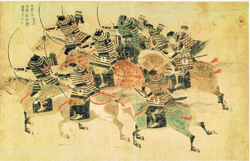
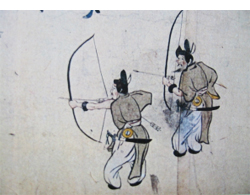
When Yoritomo no Minamoto founded the Kamakura Shogunate in 1192, he established the Samurai Ethic, stating that a samurai must devote himself to reaching a spiritual height by mastering the art of horseback archery. This was taken from Azuma Kagami (Mirror of the East), a history book written in the Kamakura Period, that various forms of horseback archery such as Inuoumono (dog hunting) and Kasagake (hat shooting) were well-practiced to train the body and mind of the samurai during this age.
At Tsurugaoka-Hachimangu Shrine, Yabusame (horseback archery) is performed as a part of the Hojoe ritual up to this day. Makigari hunting became extremely popular during the Kamakura era, and bows that held more of a ritual meaning in the Heian Era regained their role in warfare. However; Inuoumono and Kusajishi (grass deer target archery) with their strict rules developed as sporting events.
Development in Technology
Archery took innovative strides during the decades of conflict that started from the Period of North and South Dynasties up to the Muromachi Period.
During Emperor Godaigo's reign, Sadamune and Tsuneoki Ogasawara compiled the way of the bow that were handed down and practiced within the Samurai community and established the foundation of the school for Japanese horseback archery. Later on, the Ogasawara family was engaged as the grand master of horseback archery up until the Edo Period. How archery was practiced in those days is described thoroughly in the Ryoshun Ozoushi written by Ryoshun Imagawa. Danjoh Masatsugu Heki, the founder of the Heki School is also from this period. The Heki School spread as archery become most fit for actual combat. Masatsugu's style was passed on to his disciple, Shigekata Yoshida, and then split to two schools, Sekka and Izumo. From the Sekka School, Dosetsu, and from the Izumo School, Insai and Okura. Because of these gifted predecessors, the art of archery advanced rapidly.
Years later a lateral branch, the Chikurin School, originated by Josei Chikurinbo was established and commonly practiced in the Owari and Kishu areas. Many schools deriving from others were also established during the 150 years between the 15th and 17th century (the end of Muromachi Period and the beginning of Edo Period).
Major schools such as the Yamato School by Kozan Moriyama in the Genroku Period and the Honda School by Toshiazane Honda in the Meiji Era were founded thereafter.
The innovation in the art of Japanese archery is described in Takatada Kikigaki written by warlord, Takatada Taga. In his book, there is mentioning of the pros and cons of yugaeri (turning of the yumi), a technique enabled by the curved bow.
Archery as a Form of Spiritual Training
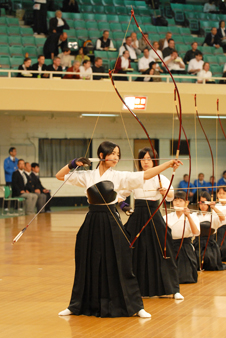
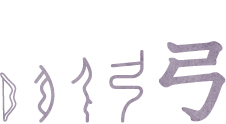
After guns were introduced into Japan, the age of warfare using bows and arrows ended and archery became a form of training of the body and mind. This lead the art of archery to become more refined through this transition.
One example is Toshi-ya (Long-range archery). Toshiya began in the 12th century but not until the 16th century did it become popular. According to the historical records from 1606, the number of arrows that hit the target was 51. In 1661, this record was broken by an archer, Kanzaemon Hoshino with 8000 arrows. However in 1686, another archer Daihachi Waza hit a new record.
Toshiya requires fast-shooting using the Uchikiri technique, so special gloves were designed to enable the archer to move their thumbs freely. This glove is the origin of kataboshi used in Kyudo today. Daihachi Waza was able to shoot 13,033 arrows within his 24 hour time limit and hit the target 8,133 times.
Modern Kyudo
During the warless Edo Period, archery was pursued as an art and developed into Kyudo meaning "the Way of the Bow". However at the Kobusho, an official military arts school established by the Edo Shogunate excluded Kyudo from the curriculum after a year on the grounds that it could not be adapted to actual combat in the age of guns and Western military training. But outside the school, guns were for low-ranked foot soldiers and horseback archery was still widely practiced in the samurai community. During the Meiji Era, when the Dai Nippon Butoku Kai was established in Kyoto, naturally Kyudo was included and encouraged.
During the Taisho Era and the beginning of Showa Era, Kyudo was adopted in high schools as an extra-curricular activity, if not a regular subject. But when World War 2 broke out, the Ministry of Education changed their policy and once again Kyudo was excluded as it did not link directly to actual combat. After the war, all martial arts were banned from schools.
In 1951, Kyudo was permitted to be practiced at schools again. In 1967, Kyudo was adopted as a regular high school curriculum. The educational and athletic aspect of Kyudo was recognized and revaluated. Modern Kyudo launched thereafter as part of schools' physical education.
The mission of modern Kyudo is to pursue how Kyudo can contribute educationally under the new spiritual concept by taking any possible scientific approach available and to spread the art.








